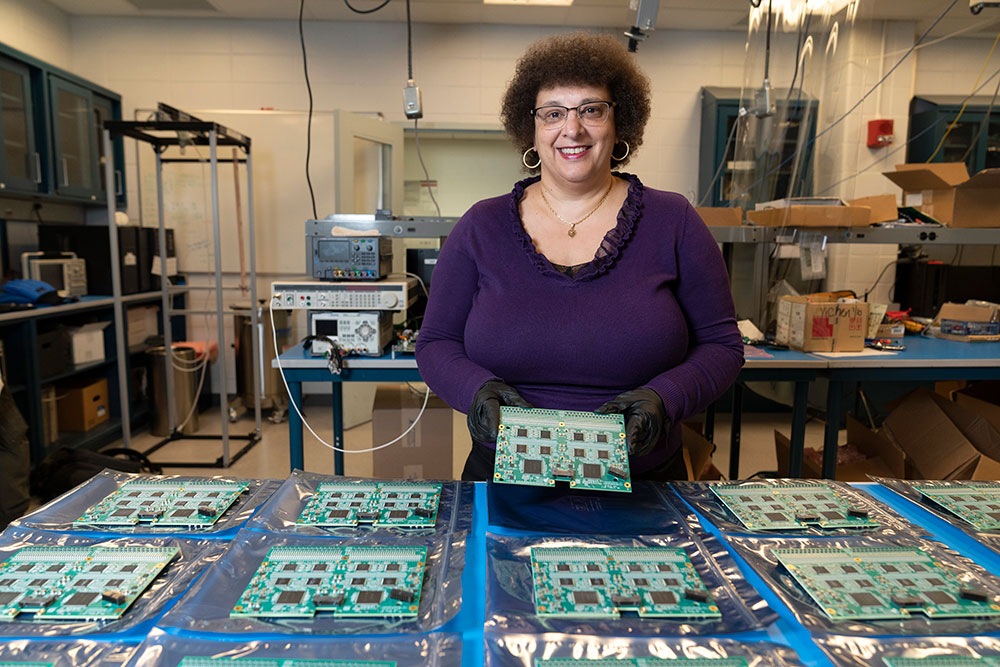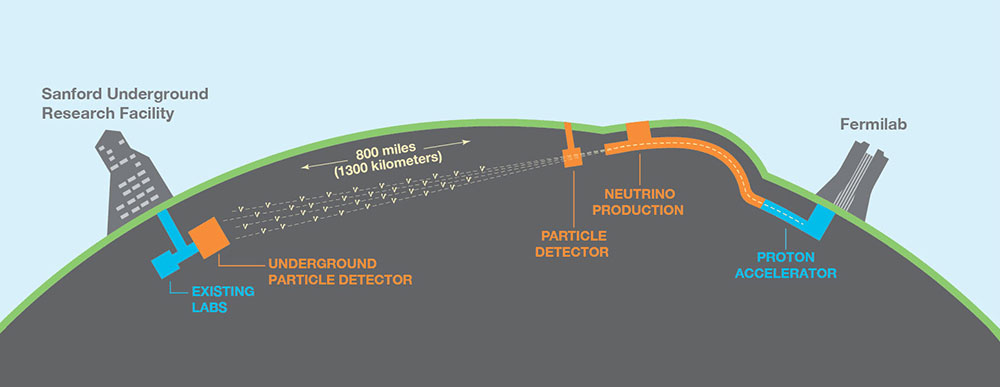Brookhaven Lab Physicist Mary Bishai Elected DUNE Co-Spokesperson
Bishai will serve alongside University of Bologna physicist Sergio Bertolucci to lead the world's largest neutrino collaboration
March 20, 2023
 enlarge
enlarge
Mary Bishai, a distinguished scientist at Brookhaven Lab, has been elected co-spokesperson of the Deep Underground Neutrino Experiment (DUNE). Here, she is shown in the "cold microelectronics" testing station at Brookhaven where scientists developed specialized electronics that can operate in DUNE's cryogenic detector.
UPTON, NY—Mary Bishai, a distinguished scientist at the U.S. Department of Energy’s (DOE) Brookhaven National Laboratory, has been elected co-spokesperson of the Deep Underground Neutrino Experiment (DUNE). In her new role, Bishai will lead DUNE’s 1,400-member international collaboration—the largest neutrino collaboration in the world.
Currently under construction, DUNE will send the world’s most intense neutrino beam hundreds of miles through Earth’s crust, from DOE’s Fermi National Accelerator Laboratory (Fermilab) in Batavia, Illinois, to the Sanford Underground Research Facility in Lead, South Dakota. The goal is to study the nature of neutrinos—ghostlike particles that travel at nearly the speed of light.
Bishai will lead this monumental project alongside co-spokesperson Sergio Bertolucci, a physics professor at the University of Bologna and former Director of Research at CERN.
“This partnership is fantastic,” Bishai said. “While I’ve been heavily invested in the U.S. side of the DUNE collaboration for many years, Sergio is well-connected with the international community. I have known him for a long time, and he is a wonderful person to work with.”
 enlarge
enlarge
Currently under construction, DUNE will send the world's most intense neutrino beam hundreds of miles through Earth's crust, from Fermi National Accelerator Laboratory in Batavia, Illinois, to the Sanford Underground Research Facility in Lead, South Dakota.
Bishai begins her term as co-spokesperson with nearly 20 years of experience in neutrino physics, largely at DUNE and precursor experiments. Indeed, Bishai’s career has grown in parallel to the evolution of DUNE.
When Bishai first joined Brookhaven Lab as an assistant physicist in 2004, she was hired to support the MINOS experiment at Fermilab. But Bishai’s senior colleagues were also developing the first concept of a very long baseline neutrino experiment in the U.S., one that would exceed 1,000 kilometers (about 600 miles). Over time, Bishai helped turn that concept into a proposal for a new experiment, DUNE’s precursor—the Long-Baseline Neutrino Experiment (LBNE).
By 2012, LBNE was under development and Bishai was chosen to be a project scientist.
“I think that was the most fun job I’ve ever had,” Bishai said. “It was my responsibility to marry scientific vision to the actual project. I interfaced between the scientists and the engineers to make sure we met scientific requirements and had a practical design.”
Once LBNE was reorganized into DUNE and the Long Baseline Neutrino Facility (LBNF), Bishai completed her role as project scientist but continued to develop the experiment’s science program as a senior physicist at Brookhaven. She later chaired DUNE’s review office, managing independent reviews of the experiment’s technical components.
Throughout her career, Bishai has made impact in every area of DUNE, from the physics to the project—and now, the collaboration management.
One of Bishai’s goals as co-spokesperson of DUNE is to improve the collaboration’s governance with a focus on diversity, equity, and inclusion (DE&I).
“We have more than 1,400 collaborators from over 30 countries and 200 institutions, and that comes with many different cultures and approaches,” Bishai said. “We need to improve communication, ensure everyone has a good working environment, and involve the whole collaboration.”
In addition to improving DE&I, Bishai is committed to keeping the project on track as it progresses through the construction phase and new challenges arise.
“We have to make sure all the stakeholders in the U.S. and abroad are ready to proceed with the construction of the first two of the four detectors envisioned for DUNE,” she said. “We are also starting the R&D and international effort to raise the resources needed to build the last two detectors.”
Having a DUNE spokesperson coming from Brookhaven Lab is a benefit to the experiment and its leadership team. Scientists and engineers at Brookhaven have made critical contributions to DUNE from its inception, from developing the “cold microelectronics” that can operate in the experiment’s cryogenic detector to creating a custom software package for processing neutrino signals.
“It’s come around full circle,” Bishai said. “Having a Brookhaven scientist in top leadership of DUNE is exciting, but we’ve always had a leading role in this experiment. Brookhaven’s DUNE collaborators span several Lab departments and divisions. We have experts in the time projection chamber design, in the detectors, and the physics. Having this experience at my fingertips means I can get answers quickly and efficiently to move the project forward, while being sure to avoid conflicts of interest. I represent 1,400 people now, not just Brookhaven.”
Thinking ahead to DUNE’s next few years, Bishai says she is most excited for DUNE’s initial construction phase. Excavation for DUNE reached the halfway mark in early 2023.
“I’m looking forward to walking across that 66-meter cryostat, or at least standing on a walkway looking out at that cryostat,” Bishai said. “I’ve been doing this for 17 years and it was just a drawing on a paper when I came to Brookhaven. I want to see that drawing come to life.”
Brookhaven’s contributions to DUNE are supported by the DOE Office of Science.
Brookhaven National Laboratory is supported by the Office of Science of the U.S. Department of Energy. The Office of Science is the single largest supporter of basic research in the physical sciences in the United States and is working to address some of the most pressing challenges of our time. For more information, please visit science.energy.gov.
Follow @BrookhavenLab on Twitter or find us on Facebook.
2023-21011 | INT/EXT | Newsroom









